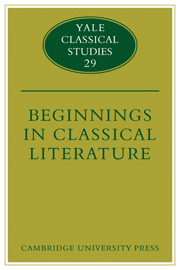Book contents
- Frontmatter
- Contents
- Introduction: beginning at Colonus
- How Greek poems begin
- The Muse corrects: the opening of the Odyssey
- Sappho 16, Gorgias' Helen, and the preface to Herodotus' Histories
- Tragic beginnings: narration, voice, and authority in the prologues of Greek drama
- Plato's first words
- Plautine negotiations: the Poenulus prologue unpacked
- Proems in the middle
- Openings in Horace's Satires and Odes: poet, patron, and audience
- An aristocracy of virtue: Seneca on the beginnings of wisdom
- Beginnings in Plutarch's Lives
- “Initium mihi operis Servius Galba iterum T. Vinius consules …”
Proems in the middle
Published online by Cambridge University Press: 10 January 2011
- Frontmatter
- Contents
- Introduction: beginning at Colonus
- How Greek poems begin
- The Muse corrects: the opening of the Odyssey
- Sappho 16, Gorgias' Helen, and the preface to Herodotus' Histories
- Tragic beginnings: narration, voice, and authority in the prologues of Greek drama
- Plato's first words
- Plautine negotiations: the Poenulus prologue unpacked
- Proems in the middle
- Openings in Horace's Satires and Odes: poet, patron, and audience
- An aristocracy of virtue: Seneca on the beginnings of wisdom
- Beginnings in Plutarch's Lives
- “Initium mihi operis Servius Galba iterum T. Vinius consules …”
Summary
How to begin a poem forms an established part of rhetorical theory. But in practice poets know that the solemn celebration of a beginning is something that far transcends rhetoric: the exordium is an inauguration, almost a liturgy which mediates the text's passage and thereby permits it to escape from silence and to enter into the literary universe. At the border between fully poetic speech and speech still outside of poetry, the proem – the preliminary announcement of a poem which follows – is already song and is not yet song. When the poet invokes the Muse to inspire him (or in hymns invokes the divinity to whom the hymn is addressed), he imposes a precise delimitation upon the “contents” of his poem. By indicating its essential themes (this or that story – or part of a story) he outlines the limits of a discourse which was undefined as long as it was merely virtual. In his discussion of the proem, Aristotle defines it in this way: δεῦγμά ἐστιν τοῦ λόγου, ἵνα προειδῶσι περὶ οὗ ὁ λόγος, καὶ μὴ κρήμηται ἡ διάνοια (“the proem provides a sample of the subject, in order that the hearers may know beforehand what it is about, and that the mind may not be kept in suspense,” Rhet. III 1415, a12f.).
- Type
- Chapter
- Information
- Beginnings in Classical Literature , pp. 147 - 160Publisher: Cambridge University PressPrint publication year: 1992
- 5
- Cited by



